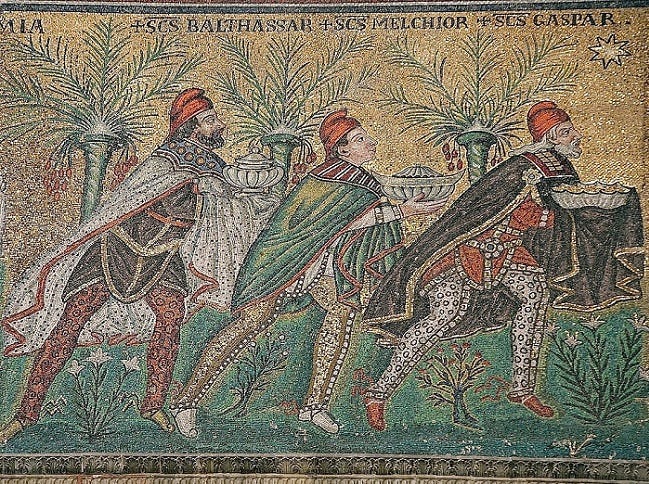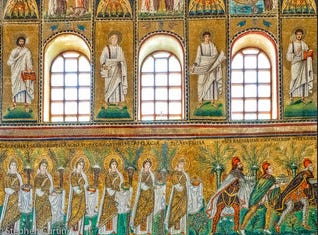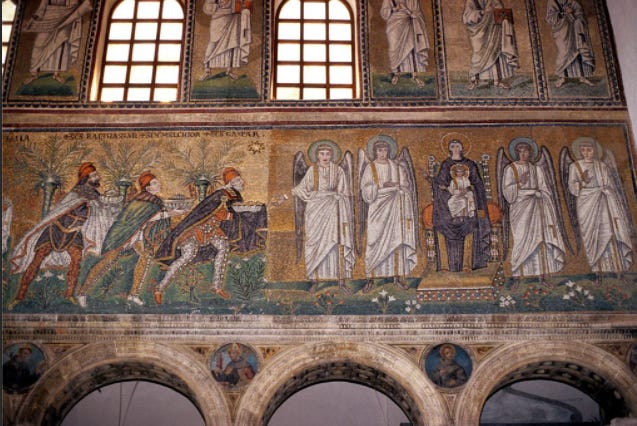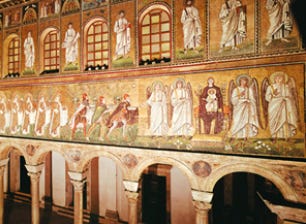Stunning Byzantine Mosaic Contains Early, Magnificent Depiction of the Three Magi
Today is the feast of the Epiphany (the visit of the Magi to the Christ Child) and, in the East, of the Theophany (the baptism of Jesus). Epiphany is an even more ancient Christian feast of Christ’s birth than that of Dec. 25 Christmas Day, dating back to the 2nd century, and there was already a fresco of the Magi coming to adore the Child Jesus in a third-century A.D. catacomb. Matthew 2 describes the journey of the Magi, their meeting with treacherous Herod, their gifts to and adoration of the Child Jesus, and their subsequent departure from Israel without returning to Herod. What the gospel does not say is exactly how many Magi or wise men (often identified as kings) did in fact visit Jesus. Tradition usually puts the number of the Magi at three, because they gave three gifts: gold (for a king), frankincense (for a priest), and myrrh (for a sacrifice). Some Christian traditions make the number of the Magi as high as twelve, however. A mid-6th-century mosaic said by scholars to be one of the earliest artistic depictions of the Magi, though, shows three kings—and even includes their names.
One of the earliest depictions of the Three Magi is said to be a mosaic in Sant’Apollinare Nuovo, a 6th-century basilica church in Ravenna, Italy which was built when the Roman empire was based in Constantinople. Ravenna was, at the time the mosaic was made, perhaps the most significant city politically in Italy, at least from a Byzantine point of view, because Ravenna was where the Western representative (or exarch) of the Roman emperor lived. The basilica of Sant’Apollinare Nuovo was originally built c. 506 A.D. by Ostrogoths; interestingly, the Ostrogoths were Arian heretics (meaning they believed the Son of God was created and thus not fully divine). The basilica was later significantly redone, however, after the Byzantine/Roman emperor Justinian was in control of Ravenna, and it was during this mid-6th-century period of Byzantine control and redecoration that the stunning mosaic of the Magi was created. The mosaic seems to be the source for the names usually associated with the kings (being the first recorded mention of them), though there was almost certainly some sort of tradition behind the names: Gaspar (or Caspar), Melchior, and Balthassar.
Notice that one king is youthful and beardless, one king is bearded in the prime of his life, and one king is an old man with hair and beard of white. The Magi were traditionally depicted as representing the three main stages of man’s life: youth, prime or middle age, and old age.
While the image above is a close-up on the Magi, the kings are actually part of a larger mosaic, heading up a procession of virgins:
The Magi are processing towards the Blessed Virgin Mary and the Child Jesus, enthroned and flanked by angels:
Here is a view of the entire scene on the basilica wall:
The mosaic of the Magi in Sant’Apollinare Nuovo is not only a testament to the artistic skill of those who made the mosaic but also a beautiful illustration of the story that so perfectly represents how Jesus turned the proud conventions of the world upside down: the story of the learned pagan kings who traveled long distances just to pay homage to a poor baby who was really the Creator and King of the world.
(A 2020 art and history lecture by Dr. Brendan McGuire of Christendom College was a source for this article.)
(Last image courtesy of Biblical Archaeology.)







